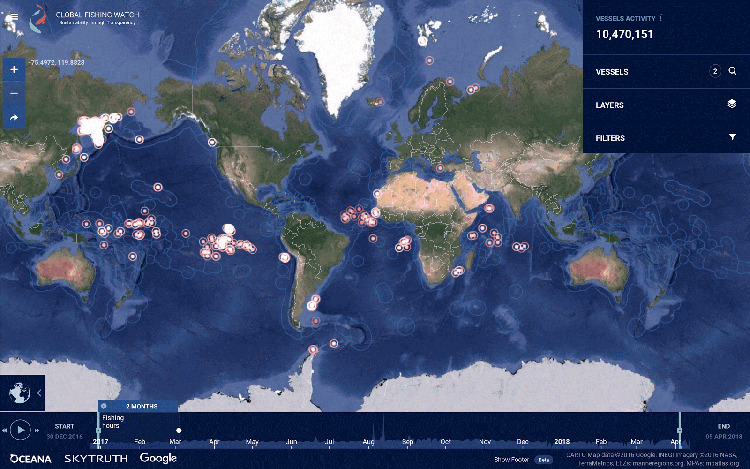testsetset
Artificial intelligence is the beating heart at the center of delivery robots, autonomous cars, and, as it turns out, ocean ecology trackers. In a blog post on Friday, Global Fishing Watch, a platform founded by Google, Skytruth, and Oceana that monitors fishing activity around the globe, announced the addition of two new data layers to increase “transparency” and “awareness” around overfishing.
One of the new layers tracks transshipment, a method whereby one fishing vessel offloads its catch to another, refrigerated ship at sea. It’s often used to combine illicitly caught fish with legal seafood, and it usually takes place in international waters, making it difficult for authorities to track.
Working from a database of 300,000 ships across 12 categories, Global Fishing Watch trained machine learning algorithms to identify when a fishing vessel is docked alongside a refrigerator vessel, and to determine the likelihood that transshipment is taking place. It automatically plots those spots on the map, highlighting hotspots that warrant further investigation.
Illegal, unreported, and unregulated (OUU) fishing accounts for an estimated $23.5 billion worth of fish annually worldwide, or roughly one in every five fish that goes to market, according to a study cited by Global Fishing Watch.
June 5th: The AI Audit in NYC
Join us next week in NYC to engage with top executive leaders, delving into strategies for auditing AI models to ensure fairness, optimal performance, and ethical compliance across diverse organizations. Secure your attendance for this exclusive invite-only event.
Fishing vessels without GPS devices known as Automatic Identification Systems (AIS) present another challenge for the authorities, one Global Fishing Watch tackled with a novel solution: monitoring brightly lit ships from space. Using data from weather satellites operated by the U.S. National Oceanic and Atmospheric Administration (NOAA), algorithms detect boats with lights from “small wooden boats with basic lights” to “massive industrial vessels with the equivalent of sports stadium lighting,” allowing it to track an additional 10 to 20 thousand boats in all.
Global Fishing Watch, which launched in 2016, shows a world map of fishing vessels moving in “near real-time” (72 hours from the present time), and can extrapolate the location where ships are fishing, the type of fishing they’re involved in, and even the size of their engines. Before the launch of today’s new filters, the system’s neural network was able to identify more than 70,000 commercial shipping vessels.
Fishing isn’t the only activity researchers are tracking with the help of AI. In a paper accepted in the Proceedings of the National Academy of Sciences (PNAS) this week, scientists detailed a system that can identify, describe, and count wildlife in the Serengeti with 96.6 percent accuracy. And in November 2016, scientists at Queensland University used Google’s TensorFlow machine learning framework to train an algorithm that can automatically detect sea cows in ocean images.


